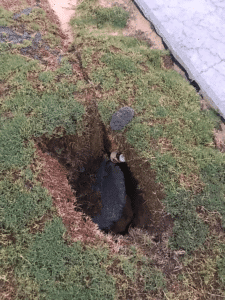 Seawalls serve an important purpose in regards to shoreline protection and adjacent structure stability. Over time though, hydrostatic pressure, storm surges, and aging seawalls will require routine maintenance be performed on the walls themselves as well as on soil behind the wall. This is not about proper seawall construction, but it is about a recent project where one seawall repair was superior to another.
Seawalls serve an important purpose in regards to shoreline protection and adjacent structure stability. Over time though, hydrostatic pressure, storm surges, and aging seawalls will require routine maintenance be performed on the walls themselves as well as on soil behind the wall. This is not about proper seawall construction, but it is about a recent project where one seawall repair was superior to another.
We were brought in on a project where a seawall along coastal waters was experiencing heavy erosion and washouts. This particular project was part of a larger scale revitalization to a public access area, so safety and aesthetics were very important. Prior to our involvement, the repair plan to fill the voids called for flowable fill, a cementitious mixture, to be pumped into all known voids. This process was completed on a Friday and when the site was evaluated the following Monday, over half of the voids were back. Why did this happen? Below are a few reasons:
-
Flowable fill is a cementitious mixture. Cementitious means its made of concrete and Flowable means it has fluid properties. Cement has a cure time and it is heavy. So, pumping this into a void caused by water infiltrating an already weak seawall means two things:
-
Water is present so a longer cure time is expected. Longer cure time means more time for water to undermine the seawall.
-
Flowable fill relies on volume to fill voids. More volume means more weight. More weight on a weak/failing wall could make matters worse by adding weight to a weak metal wall.
-
-
Part of sediment loss from behind the wall was due to larger, rusted holes. Based on the factors stated above, flowable fill will have a hard time setting up with water actively coming through the wall, which means you never get a complete seal on the holes.
-
Flowable fill doesn’t combine with soil, but rather fills up large voids that it can flow to. It is a thick material which means any small water paths will be hard, if not impossible, to reach.
The Solution:
Permeating, hydrophobic, polyurethane resins were used to seal off the problem areas. The resins used were a bit of a hybrid chemical, meaning they have permeating and expansive qualities. It should be noted that the expansive qualities of this resin are not synonymous with the qualities of our rigid, two part expanding foams used to lift and stabilize structures, which could also cause a few issues (blog post coming soon) when repairing seawalls.
Two days after the repair was completed, this area was hit with a tropical storm dumping 8” of rain in a matter of days and sending a storm surge that caused waves to crash over the seawall. A thorough site evaluation the next week revealed the polyurethane resin repair held. So, why was this repair successful?
-
For starters, with active leaks and holes of size in a seawall, you want to stop the water inflow as fast as possible so that material behind the wall can be strengthened. Material used here had an expansion rate of 50x its liquid state and is moisture activated. This combined with hydrophobic properties means that as soon as the resin touched moisture, it began a process to work to seek and force out all water in the area. This is saying a lot when you take into account the material was holding off pressure from coastal tides.
-
Resins used have a very low viscosity (approximately 100cps) and are injected under pressure so anywhere water is going, it can go. This is important because we are not just sealing the small holes, we are finding the small paths that flowable fill simply cannot get to. There were instances where we had material reaction 10-15 ft from our injection point, meaning water was traveling that far to cause problems. Flowable fill can’t find that.
-
Remember we said this was a hybrid material and the permeation qualities are probably the most important part of this repair. Once the active leaks were sealed, the resin then permeates through the soil seeking out all large and hairline water paths. As interaction with soil and moisture occurs, soil particles are combined and bound together to create a solid, water impermeable mass everywhere water once traveled. Extra care is also taken to make sure the surrounding areas are treated to mitigate future erosion. This is important because we are stabilizing the natural water paths, where water has been and will be trying to go, we aren’t just putting up a “dam”. This method stops the water intrusion at its source and then strengthens the area.
This one got long winded, we know, but seawall failures are common and can be expensive and unsafe if done incorrectly. We want to make sure you have access to all the information necessary to make an informed decision. The initially failed repair was not at all due to negligence, but simply a lack of information. They weren’t aware of a better way. There in lies our mission, to solve problems permanently and educate while doing so.
Be on the lookout for the next blog in this series. We will compare permeating and expanding resins regarding seawall repairs and why you should ask questions about the type of resin being used on your project.


